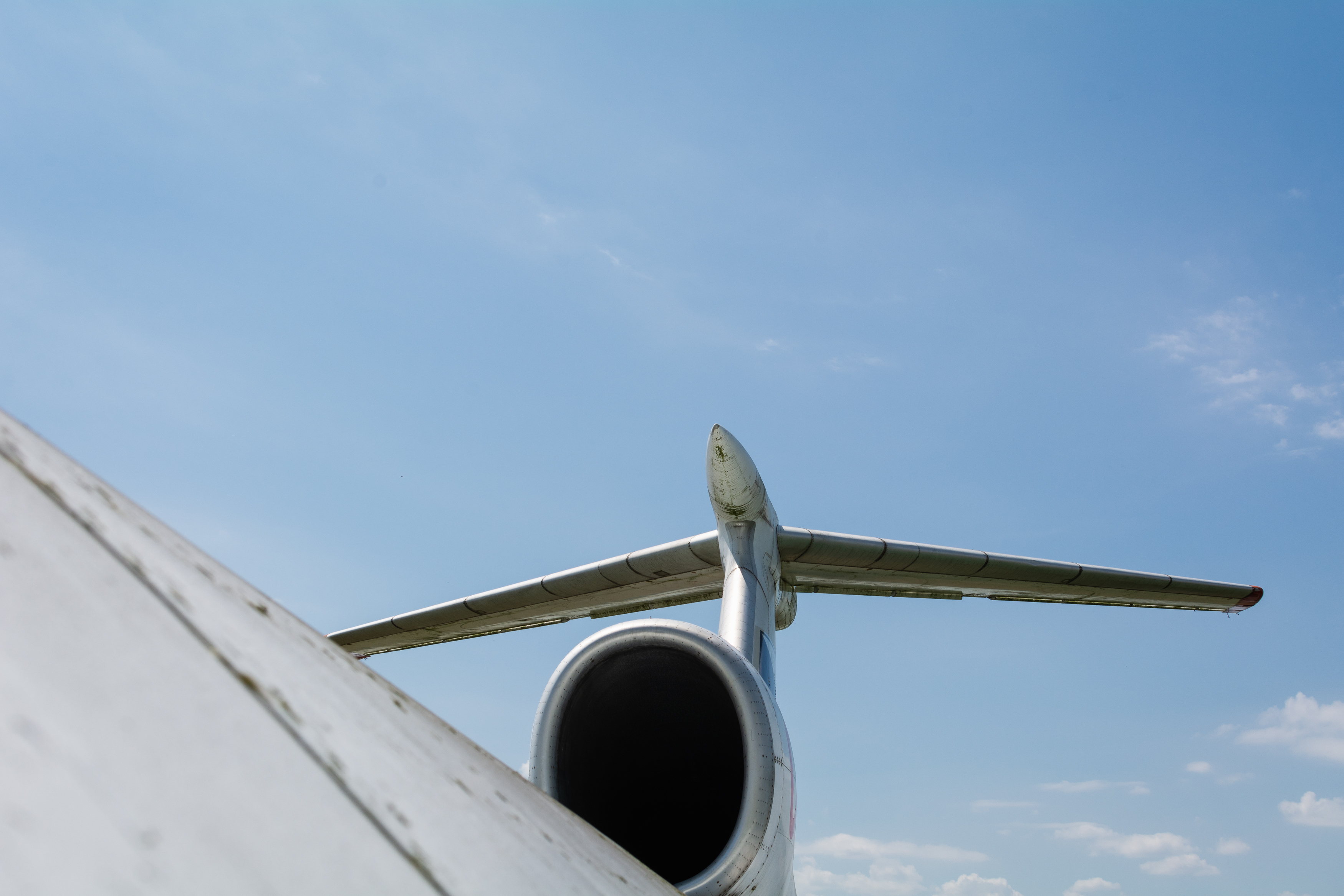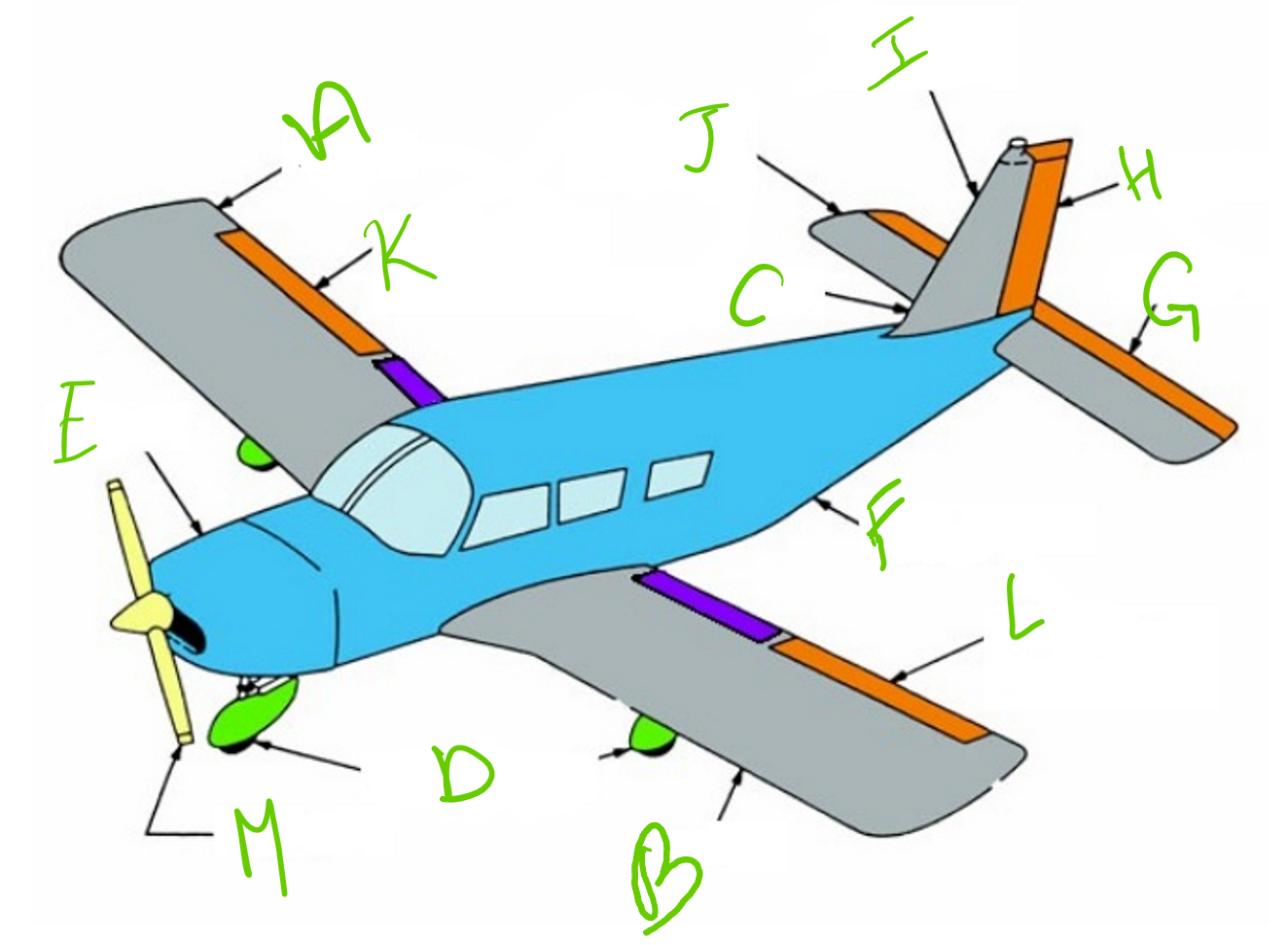Stabilizer Aircraft - Disconnect the mechanical backup actuator of the horizontal stabilizer, apply step signal of 5° amplitude at the control handle of the horizontal stabilizer through a displacement signal generator, measure the displacement signal of the handle and the output displacement signal of the rocker arm at the tail end and process them into time course curve of tested signals, and then calculate the delay time of the tested system, rise time (time to reach 95% steady-state value), overshoot, oscillation times and the steady-state time (time to reach ±5% steady-state error zone) according to the curve.
Assembly loads need to be calculated to cope with the loads coming from hinge line misalignment during component assembly. Improvements in manufacturing techniques tend to reduce assembly loads and consequently reduce bearing and fitting structure weights. An alternative way to solve the misalignment at hinges is to bore the hinges and bring the line concentricity into the required tolerances band with a special tooling attachment on the assembly jig [4].
Stabilizer Aircraft
Disconnect the mechanical backup actuator of the horizontal stabilizer, apply sinusoidal signals with amplitude of 5° and frequency of 0.1–2 Hz at the handle with a displacement signal generator, measure the handle displacement and handle force and the output displacement of the rocker arm at the tail end and analyze the test data and curve to obtain the frequency characteristic of the output displacement of rocker arm at tail end relative to the handle displacement and handle force.
Content And Methods
Disconnect the mechanical backup actuator of the horizontal stabilizer, apply step signal of 10° amplitude at the control handle of the horizontal stabilizer through a displacement signal generator, measure the displacement signal of the handle and the output displacement signal of the rocker arm at the tail end and process them into time course curve of tested signals, and then calculate the delay time of the tested system, rise time (time needed to reach 95% steady-state value), overshoot, oscillation times and the steady-state time (time needed to reach ±5% steady-state error zone) according to the curve.
Both the primary control surfaces and smaller secondary trim tabs are visible in the image below. Trim tabs allow the pilot to fix the control position such that the aircraft will remain in a fixed aerodynamic configuration with the pilot’s hands off the control column.
Every flight control computer has two channels: a command channel and a monitoring channel. The command channel operates the allocation mission whereas the monitoring channel guarantees the command correction. Flight control computers adopted dissimilar redundant microprocessors and totally different control software. The flight control primary computer (FCPC) utilizes an Intel 80386 microprocessor, in which Assembly language is adopted for the command channel, whereas PL/M language is adopted for the monitoring channel. An Intel 80186 microprocessor is used for a flight control secondary computer (FCSC), where Assembly language is adopted for the command channel and the Pascal language is adopted for the monitoring channel. A340 aircraft control surface allocation is shown in Figure 1.27, where three hydraulic power supply systems (blue (B), green (G), and yellow (Y)) provide the hydraulic power to the flight control actuators.
Ever wonder why airplanes have a vertical tail? Wings, of course, are horizontal to create lift, so conventional wisdom may lead you to believe that a horizontal tail is more effective than a vertical tail. While airplanes often have horizontal flaps on the tail, they also have a long and vertical tail structure known as a stabilizer. Also known simply as a fin, the stabilizer points upwards to provide stability. To learn more about the purpose of the stabilizer and why it’s used on so many airplanes, keep reading.

In Conclusion
As the name suggests, the conventional tail arrangement is the most common. In this configuration, the vertical tail sits at the rear of the fuselage with the horizontal stabilizer attached to the fuselage below the vertical tail. This arrangement works well when the aircraft engines are placed under the wing (as shown on the B737-800) where the hot engine exhaust may be kept well away from the horizontal stabilizer. This is a structurally efficient arrangement as the horizontal stabilizer is fixed directly to the fuselage and therefore can introduce and distribute the resulting load directly into the fuselage structure.
A380 aircraft have moved away from mechanical control by replacing it with an electrical backup hydraulic actuator (EBHA). Although there is no mechanical control channel in A380, its completely dissimilar redundant design makes it reliable and safe. Application of EHA eliminates pipes between the centralized hydraulic power supply and the actuator, thus reducing the weight and improving the safety, efficiency, reliability, and maintainability of the aircraft. The electrical powered flight-by-wire actuator is becoming increasingly used for primary flight controls. As its reliability has improved, the power-by-wire actuation systems has eliminated hydraulic systems, shown in Figure 1.29.
Disconnect the mechanical backup actuator of the horizontal stabilizer, measure the force and displacement at the control handle of the horizontal stabilizer, draw the force–displacement relation curve, analyze test data and curve and calculate frictional force and unbalanced force of the system with formulate (5.1) and (5.2).
In the trim function inspection, the trim function and trim logic of the horizontal stabilizer, aileron, and rudder, respectively, under the “normal,” “degraded,” “simulated,” and “mechanical” modes should be checked. The trim logic of the horizontal stabilizer is relatively complex, which mainly includes trim cutoff logic, electrical trim logic, mechanical trim logic, and trim function inspection.
What Is A Vertical Stabilizer?
The elevator and rudder are also constructed from CFRP sandwich panels, ribs, and spars, and are hinged from the stabilizer or fin-fixed trailing edge. The rudder incorporates a lower tab of CFRP sandwich construction. The rudder is fabricated in Australia by ASTA and Hawker DeHaviland fabricates the elevators. A more detailed description of the 777 empennage components can be found in Schreiber and Quinlivan (1993).
This is part 8 in the Fundamentals of Aircraft Design series. In the previous posts we’ve looked at both the wing and fuselage in some detail. Now we move onto the aircraft tail section and examine the function of both the horizontal and vertical tail. We'll then introduce an empirical method to size both surfaces on a new aircraft design.
Other instances of WFD led eventually to mandatory FSFT from 1998 onwards; and in 2011 the limit of validity (LOV) concept for aircraft above 34,000 kg. The LOV concept requires FSFT to determine the onset of WFD [11], and as such effectively sets a Safe-Life equivalent for this category of aircraft.
This accident prompted (i) reconsidering the problems of ageing aircraft: it became clear that some inspection methods and schedules were inadequate and required supplementary programmes; and (ii) the need for damage tolerance (DT), which replaced the Fail-Safe design principles in 1978.
Sizing The Stabilizer Surfaces
Using the tail volume coefficients given above, the horizontal and vertical tail area can be estimated. Once the stabilizer area is know, the planform can be sketched out after selecting an aspect and taper ratio (the Wing Plot Tool on this website is a useful way to visualize what the surface will look like).
In the trim function inspection, an appropriate flight state is set and different working modes are switched through the fly-by-wire flight control panel to check the trim function and trim logic of the horizontal stabilizer, aileron, and rudder.
Stabilators are designed to pivot about their aerodynamic center and, as a consequence, very little pilot effort is required to make a control input. This amount of effort does not vary with airspeed or angle of attack. To prevent over-controlling, the stabilator on a light aircraft is fitted with an anti-servo tab on its trailing edge. Control input causes the anti-servo tab to deflect in the same direction as, but further than the stabilator. This additional deflection induces an aerodynamic force which resists the pilot input. In most cases, the anti-servo tab also acts as a trim tab.
Technically, airplanes don’t have a vertical tail; they have a vertical stabilizer, which is found on the tail. The purpose of the vertical stabilizer is to stabilize the airplane during flight. It helps to control airplanes so that they aren’t adversely affected by strong winds. Hopefully, this gives you a better understanding of the vertical stabilizer.

Control Surfaces
The A330/340 FBW system inherited the design principle of A320. The FCS consists of three flight control primary computers and two flight control secondary computers without a special FAC, Figure 1.26 [6]. The pitch control and rudder control still retain mechanical manipulation.
The control performance test covers the control command-control plane relation, the control force–displacement relation, system clearance and starting force. Aileron control channel is taken as an example below to introduce the evaluation method of the results of the control performance test.
The vertical stabilizer is an airplane component that many people simply refer to as a “vertical tail.” It’s located on the aft of an airplane’s fuselage where it extends vertically. Unlike the wings, the vertical stabilizer doesn’t create lift. Instead, it lives up to its namesake by stabilizing the airplane.
Finally, it is worth pointing out that a horizontal stabilizer is not always a prerequisite to produce a stable aircraft. Flying-wings like the Northrop Grumman B-2 Spirit are designed with a reflexed airfoil which allow the aircraft to remain statically stable without a horizontal stabilizer provided the aerodynamic center of the wing is behind the c.g.
Vertical Stabilizer
Another horizontal stabilizer configuration sometimes seen is the Canard configuration. Here the horizontal stabilizer is placed ahead of the wing rather than behind. This configuration works in much the same manner as the conventional layout except that the balancing force generated by the horizontal stabilizer (canard) is upward rather than downward. In this configuration the centre of gravity is still ahead of the centre of lift of the wing and as such the aircraft remains statically stable in the longitudinal axis.
Supply pressure to the mechanical backup actuator of the horizontal stabilizer, measure the force at the control handle of the horizontal stabilizer and the motion displacement of the mechanical input rocker arm, draw the force–displacement relation curve, analyze test curve and data to determine the starting force of the system.

Disconnect between the mechanical backup actuator of the horizontal stabilizer and the rocker arm at tail end of the cable gearing, fix the rocker arm at tail end of the cable gearing, apply control force (forward and backward) slowly at the control handle position of the horizontal stabilizer until the handle reaches the limit position and does not move, measure the displacement of the handle, that is, system clearance. Control the handle in the reverse direction with the same method and measure the displacement of the handle. The sum of the clearance in both directions is just the clearance of the entire horizontal stabilizer control system.
The A380 FCS has adopted a new double architecture system, namely 2H+2E, in which the main control command is transmitted with the FBW system and power is transmitted with the power-by-wire system. This particular design philosophy, Figure 1.28, has been used in Airbus over the past 20 years, in which the centralized hydraulic power supply system and distributed electrical power supply system are simultaneously used. For example, the A380 aircraft aileron control adopts conventional hydraulic actuator (HA) power by the centralized hydraulic power supply and the EHA is powered by the electrical supply system at the same time. Under normal conditions, the HA actively drives the aileron and the EHA follows the HA. When the HA fails, the EHA drives the aileron instead of the HA.
Property Requirements For Empennage
With the progression of the Airbus family from A320 to A380, one can easily identify the integration trends. In A320 aircraft, the autopilot and flight management system are designed separately. In the case of the A330/340, the flight management and guidance computer combines the autopilot and guidance. A380 integration has progressed through synthesis of different kinds of flight control functions with stand-alone flight control computer.
ALOHA Boeing 737: In April 1988, a Boeing 737 suffered explosive decompression with a loss of part of the pressure cabin, subsequently landing safely. The physical manifestation of the accident was multiple site fatigue damage (MSD) along a critical rivet row of the upper skin lap splice. There were several contributing factors:
Fail-Safe design principles mean that major parts of the structure are (were) designed firstly to achieve a satisfactory fatigue life with no significant cracking. Secondly, the structure is (was) also designed to be inspectable in service and able to sustain significant and easily detectable damage before safety is compromised. These latter requirements were met mainly by structural design concepts having multiple load paths and established residual strength (fracture) requirements in the event of complete or obvious partial failure of one structural element.
The MRJ vertical and horizontal stabilizer torque box design was successfully completed with approximately 15% weight reduction from conventional aluminum. The approximate length, width, and height of the vertical torque box are 5500, 1250, and 400 mm, respectively (Fig. 12). The approximate length, width, and height of the horizontal torque box are 5700, 850, and 350 mm, respectively, per side, with the right hand and left hand boxes joined at the center (Fig. 13).

Horizontal Stabilizer
The elevator and rudder are both movable surfaces fixed to the trailing edge of the horizontal and vertical stabilizer respectively. Deflecting the control surface modifies the camber of the surface which induces a force normal to the direction of flight and causes, the aircraft to rotate about the center of gravity either in pitch (elevator) or yaw (rudder).
A few aircraft, like the Model 35 Beech Bonanza, have been designed with a V-tail arrangement where the three conventional surfaces (vertical tail, port (L) and starboard (R) horizontal tail sections) are replaced with two surfaces placed in a V formation. The horizontal and vertical components of the surfaces act as a horizontal and vertical stabilizer respectively. The V-tailed Bonanza was produced between 1947 and 1982 before being phased out in favor of the conventional tailed Model 33 and 36. A more recently designed V-tailed aircraft is the Northrop Grumman RQ-4 Global Hawk unmanned aerial vehicle which first flew in 1998.
The control limit inspection mainly checks the control limit of aileron, rudder and elevator. In the control limit inspection, the control column (or pedal or steering wheel) is stably and slowly operated and when it moves to the full stroke, it will be stopped and kept stable, and then the motion stroke of control plane (aileron, rudder, elevator) will be checked to see whether it is consistent with the design requirements.
Supply pressure to the mechanical backup actuator of the horizontal stabilizer, push the trim handle slowly forward to the maximum stroke and then release it. The trim handle will return automatically. Measure the deflection angle of the handle after the return, that is, the difference between the position of the handle after the return and the neutral position. Pull the trim handle slowly backward to the maximum stroke and then release it. The trim handle will return automatically. Measure the deflection angle of the handle after the return, that is, the difference between the position of the handle after the return and the neutral position.
Civil Aircraft Milestone Accidents
horizontal stabilizer in aircraft, horizontal stabilizer design, stabilizer on an airplane, vertical stabilizer on a plane, aircraft vertical stabilizer, adjustable stabilizer aircraft, aircraft stabilizer vs elevator, plane stabilizer

0 Comments